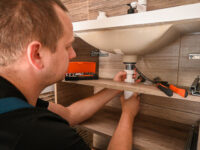Why You Should Have Your Roof Inspected
There are many reasons to have your roof inspected, including after a severe storm or when you suspect a leak. Inspecting your roof prevents damage and reduces maintenance costs.
A home inspector will check your roof’s condition, focusing on critical areas like valleys, edges and areas around chimneys and vents. The inspector will also look for sagging, missing or cracked shingles. For Free Estimate keep reading the article below.
Your roof is a complex system of interconnected elements that must all work together to properly protect your building and its occupants. An inspector assesses each component for leaks, cracks, punctures, membrane separation, and other issues that may cause serious interior damage. The inspector also examines gutters, downspouts, and drainage systems to make sure that water is channeled away from the roof to avoid structural damage and potential flooding. Vents, skylights, and HVAC units are also checked for proper sealing and insulation to prevent leaks and moisture buildup.
Roofing materials vary in durability and cost, but all have a finite lifespan. Regular inspections help identify minor concerns and allow for timely repairs, extending the life of your roof and reducing the likelihood of expensive replacement costs in the future.
A well-maintained roof is a key selling point for homes and commercial properties. Keeping your roof in top condition can increase the curb appeal and value of your property, while helping you get the most out of your homeowners’ insurance coverage.
In addition to identifying potential leaks and other damage, roof inspections can also identify energy efficiency problems. Missing shingles and poor insulation can allow cool air to escape, forcing your HVAC system to work overtime and raising utility bills. A professional can find these problem areas and make recommendations to improve your home’s energy efficiency. The inspector will also check for sagging ceilings and weakened decking, which can lead to structural issues and costly repair costs. The inspector will prepare a report detailing their findings and provide sound roofing advice. They will also recommend any necessary maintenance to keep your roof in top condition.
Flashing
Flashing is the unsung hero that guards the critical areas of your roof. Typically made of metal, it protects these intersection points where different materials meet. It’s especially important at eaves, valleys, wall/roof junctions and projections such as chimneys, dormers, skylights, vent pipes and more. It provides an extra layer of protection against water penetration and deterioration.
A skilled Nashville roofing contractor will pay close attention to your flashing during a roof inspection. They will look for gaps, rust or other signs of wear that could compromise its effectiveness. Depending on your roof type and material, they may also inspect your gutters, drainage patterns, overhanging tree branches and structural issues that could affect the integrity of your roof.
There are a number of different types of flashing, including exposed and embedded. Exposed flashing is typically made of a sheet of metal that’s visible on the surface of your roof, while embedded flashing is installed behind shingles and other roofing materials. Some common types of flashing include step and valley flashing, chimney flashing, skylight flashing and pipe boots.
During installation, roofers will carefully measure and cut flashing to the exact size required for the area it will protect. For example, step flashing requires rectangular pieces that are wider than the exposure of your shingles, while valley flashing is designed to channel water from the bottom of your roof slopes.
In addition to protecting your roof against leaks, properly installed flashing can help to reduce the risk of heat loss in cold weather. This is because flashing prevents the occurrence of frost, which can damage or corrode roofing materials.
Gutters
Gutter systems (also known as eavestroughs) are perpendicular to the roof and capture rainwater that falls onto the property. They channel the water into downspouts, which direct the flow away from the house and property, preventing moisture buildup that may damage roof components and cause structural problems for foundations or crawl spaces. Inspectors check gutters to ensure they are securely attached and are in good shape. Inspectors also look at the drainage pattern of the gutters to make sure it is directing water away from the roof and building.
Gutters are important to the health of the roof, and homeowners should regularly clean them. However, gutter cleaning can be dangerous, and it’s usually best to trust the job to professionals. Over the Top Roofing & Restoration’s expert roofing contractors are experienced in safely clearing gutters, and can inspect them for signs of wear and tear.
Regular gutter maintenance is an important part of a roof inspection, and can help protect your home from costly structural problems. Gutters can become clogged with leaves, debris, and other materials, resulting in water overflow that may damage the roof, walls, or foundation of your home. A gutter maintenance plan should include routine cleaning, seasonal inspections, and prompt repair of any minor issues.
Gutters can prevent water damage to the siding of your home, as well as reduce erosion, mold growth, and pest infestations. They can also reduce the risk of leaks in basements and crawl spaces, and protect your foundation from settling. Having properly functioning gutters can significantly extend the life of your roof, and preserve your property’s value. Gutters should be installed by qualified and reputable roofing professionals, as improper installation can result in damage to the fascia board, roof, or foundation.
Vents
Ventilation is a crucial element of roof and attic health. It prevents moisture buildup, regulates attic temperature and makes a home more energy-efficient by lowering cooling costs. But proper ventilation isn’t a “set it and forget it” aspect of roofing; it requires ongoing maintenance to ensure optimal performance.
A qualified roof inspector will check to see that the roof and attic’s ventilation system is functioning properly. The inspector will look for things like blocked, insufficient or poorly placed vents; and they’ll also assess the condition of the soffit and fascia to make sure they’re free from rot, damage or insect infestation.
Exterior vents are found on the roof’s ridgeline and can be made from metal, plastic or wood. These vents are designed to draw in cool air while allowing warm attic air to escape. They should be positioned close to the eaves, and they should be balanced with exhaust vents located on the attic floor so that air can move freely through the attic space.
Gable vents are another popular option for regulating attic air. They’re installed in the gables (the triangular sections at either end of your roof line) and offer a good balance between functionality and aesthetics, as they can be painted or stained to match other exterior features.
Chimney flues are essential for homes with fireplaces and wood stoves, as they allow smoke and gases to escape safely. Your inspector will assess the condition of your chimney and flues, checking for cracks or leaks. They’ll also make sure they’re properly capped.
Skylights
Skylights allow natural light to flood interior spaces, adding a bright and welcoming feel to a home. They also offer an opportunity to improve a roof’s energy efficiency by reducing the amount of heat loss or gain. However, they can be problematic if the incorrect type or size of glass is used and if the installation is not carefully considered. A professional can help homeowners narrow down their options and choose the best skylight for their property.
When installing a new skylight, it is important to have the roof inspected before the addition to ensure that the structure can support it. A skilled inspector can identify any roofing problems that could be exacerbated by the skylight and recommend necessary repairs. It is also a good idea to have any skylights that are already in place professionally inspected on a regular basis. This can help to prevent leaks or damage that may occur in the roof areas around the skylight and can also identify any signs of moisture build up.
Leaking skylights can be caused by debris build up or the age of the skylight’s seals. A professional can replace the damaged seals to prevent water from seeping into the ceiling area. Skylights can also become leaky if the flashing is not properly installed or maintained. Infrared scans can be used to detect trapped moisture beneath the surface of a roof, which is often difficult to spot without the proper equipment.
Skylights and roof windows can add an attractive architectural feature to a building. But they must be regularly inspected by qualified professionals like Roof Inspection Reports to ensure that the seals, flashing, and frames are in good condition and can withstand severe weather conditions. Routine roof inspections can identify issues and address them before they worsen, allowing owners to save money on repair costs in the future.






